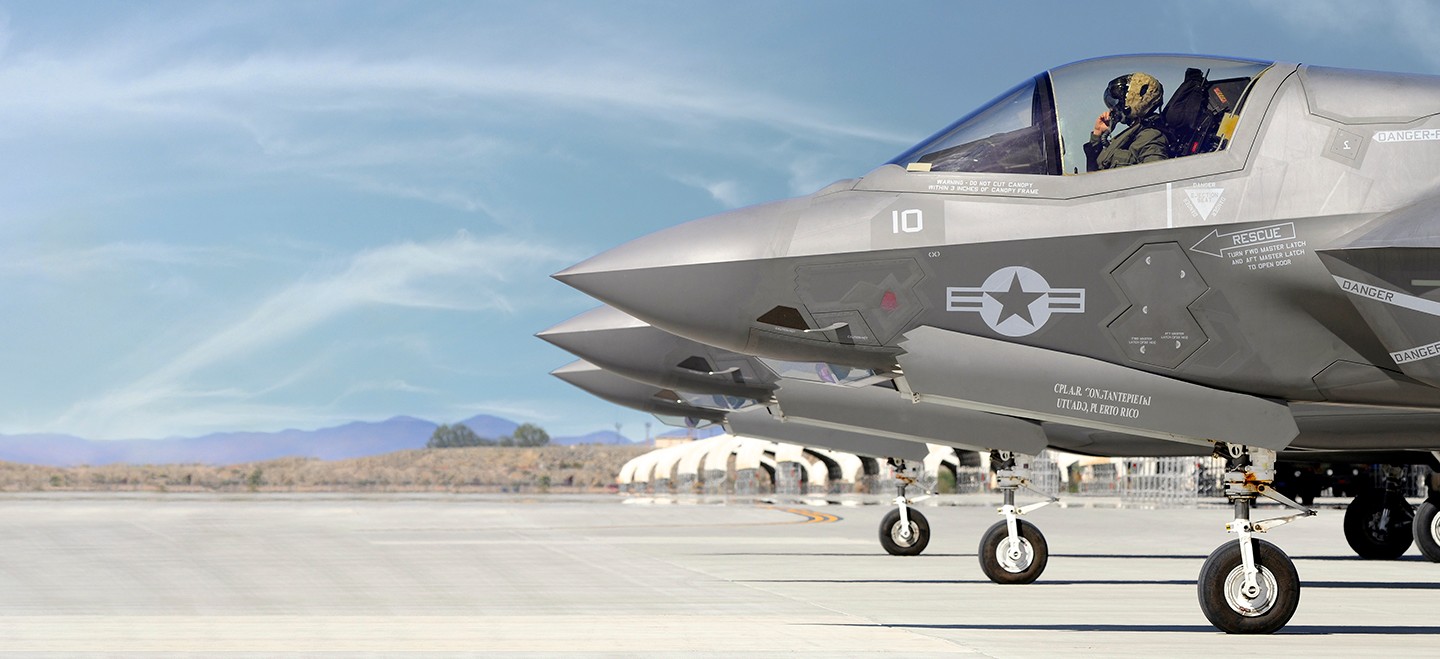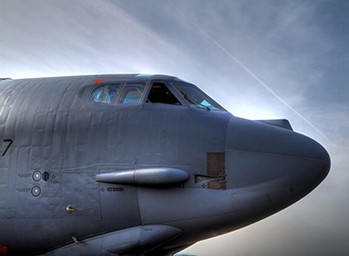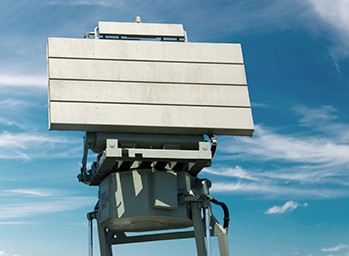
The 6 Most Advanced Fighter Jets & the Aerospace Technology That Sets Them Apart
TREND INSIGHT
DEFENSE AIRCRAFT | 8 MINUTE READ
These top fighter jets boast impressive specs, including supercruise speed, AI tech & stealth that makes them practically invisible to radar.
The term “fifth generation fighter jet” refers to combat aircraft at the bleeding edge of 21st century aerospace technology. Various factors, including speed, maneuverability, stealth, avionics, and armament determine whether an aircraft is branded as an advanced fighter jet. While multiple jets vie for this title, the aircraft discussed below stand out because of their exceptional capabilities and groundbreaking technologies.
The F-35 Lightning II: A Multi-Role Force Multiplier
The F-35 Lightning II, developed by Lockheed Martin, epitomizes the concept of a multi-role fighter. Available in three variants (A, B, and C), the F-35 caters to different service branches of the United States military, offering versatility, adaptability, and some of the most advanced technology in the air today. Its advanced stealth abilities make it extremely difficult for adversaries to spot on radar. Sensor fusion and advanced communication network connectivity provide pilots with a comprehensive view of their surroundings and potential threats, ensuring dominance across various combat scenarios.
Each variant of the F-35 is designed to meet specific operational requirements. The F-35A is a conventional takeoff and landing version for the Air Force, the F-35B has short takeoff and vertical landing capabilities for the Marine Corps, and the F-35C is a carrier-based variant for the Navy. This adaptability ensures that the F-35 can operate effectively in a wide range of environments, from land-based runways to aircraft carriers.
The F-22 Raptor: A Pinnacle of Stealth and Power
In many ways, Lockheed Martin’s F-22 Raptor personifies the advanced fighter jet. With its unrivaled stealth, supercruise capability to maintain supersonic speeds without afterburners, and advanced avionics, the F-22 dominates the skies. Its ability to engage multiple targets simultaneously, combined with superior maneuverability, makes it a formidable adversary in any conflict.
The F-22's integrated avionics suite provides the pilot with a comprehensive view of the battlespace, enhancing situational awareness and decision-making. Its thrust-vectoring engines allow for nimble maneuvers, giving it an edge in dogfights. The combination of these advanced features ensures the F-22’s reputation as a dominant force in aerial combat.
The Sukhoi Su-57: Russia's Advanced Stealth Fighter
Russia's entry into the fifth-generation fighter jet arena, the Sukhoi Su-57, showcases impressive capabilities. Combining stealth, supercruise, and advanced avionics, the Su-57 is designed to counterbalance the best of Western technology.
The Su-57 takes advantage of stealth technology, and its avionics suite includes advanced radar and electronic warfare systems, providing situational awareness and countermeasure capabilities. The Su-57's combination of speed, stealth, and firepower makes it a formidable opponent in any theater of operations.
The Chengdu J-20: China’s Long-Range Fighter
China's Chengdu J-20 represents its ambition to field an advanced fighter jet capable of competing on the global stage. The J-20 incorporates stealth features, long-range flight capabilities, and advanced avionics. Its development confirms China's growing prowess in aerospace technology and its strategic focus on air superiority.
The J-20's design emphasizes stealth, with an angular shape and internal weapons bays to reduce its radar cross section (RCS). Its long-range capabilities allow it to engage targets far from Chinese territory, extending its reach and influence. The J-20's avionics and sensor suite provide comprehensive situational awareness, making it a key asset in China's military arsenal.
Eurofighter Typhoon: European Excellence in the Skies
The Eurofighter Typhoon, a product of collaboration across Europe, exemplifies cutting-edge technology and operational versatility. With its agility, advanced sensors, and powerful engines, the Typhoon performs exceptionally in both air-to-air and air-to-ground missions. Its continuous upgrades ensure it remains a formidable force in the skies.
The Typhoon's agility is a result of its aerodynamic design and powerful engines, allowing it to maneuver aggressively in combat. Its sensor suite includes advanced radar and electronic warfare systems, providing comprehensive situational awareness and self-protection capabilities. The Typhoon's ability to integrate new technologies ensures that it remains relevant and effective in modern combat environments.
Dassault Rafale: France’s Precision Fighter
France's Dassault Rafale is renowned for its precision and adaptability. Equipped with advanced avionics, electronic warfare systems, and robust weaponry, the Rafale excels in diverse mission profiles. Its combat-proven track record and ongoing enhancements make it a cornerstone of France's air power.
The Rafale's avionics suite includes advanced radar, infrared search and track systems, and electronic warfare capabilities, providing comprehensive situational awareness and self-defense. Its robust weaponry allows it to engage a wide range of targets, from air-to-air missiles to precision-guided munitions. The Rafale's adaptability ensures that it can operate effectively in any combat scenario.
Advanced Fighter Jet Technology at a Glance
Modern fighter jets are the culmination of decades of innovation and development, incorporating the latest in aerospace technology:
Stealth
Stealth technology enables aircraft to operate undetected by enemy radar for a significant tactical advantage. Radar-absorbent materials, contoured shapes, and heat signature management contribute to minimizing aircraft visibility. The Lockheed Martin F-22 Raptor and F-35 Lightning II are prime examples, using cutting-edge stealth technology to remain elusive in hostile airspace.
Stealth technology aims to minimize the radar cross-section (RCS) of an aircraft, which measures how detectable an object is by radar systems. The F-22 Raptor, for instance, has an RCS comparable to that of a bumblebee, making it incredibly difficult to detect and identify.
Supercruise Speed
Supercruise capability, the ability to sustain supersonic flight without using afterburners, is a hallmark of advanced fighter jets. This feature allows for rapid response and engagement without the excessive fuel consumption and heat signature associated with afterburner use. The F-22 Raptor, with its powerful Pratt & Whitney F119 engines, exemplifies this technology, achieving high speeds efficiently.
Supercruise not only provides a speed advantage but also enhances the element of surprise and reduces the chances of detection. Afterburners, while effective in boosting speed, produce a significant thermal signature that can be easily tracked. By maintaining high speeds without afterburners, jets like the F-22 can engage or disengage from combat scenarios with unmatched agility and stealth.
Advanced Avionics and Sensor Systems
Modern fighter jets are equipped with sophisticated avionics and sensor systems that enhance situational awareness and combat effectiveness. These systems include radar, infrared search and track (IRST), electronic warfare suites, and data links. The F-35 Lightning II's Distributed Aperture System (DAS) provides pilots with a 360-degree view, detecting and tracking threats in real-time, thus enhancing survivability and mission success.
The avionics suite in the F-35 integrates multiple sensors into a single cohesive system, allowing pilots to have unparalleled situational awareness. The advanced radar, capable of tracking multiple targets simultaneously, coupled with the electro-optical targeting system (EOTS), gives pilots an edge in both offensive and defensive operations. This fusion of data from various sensors into a single, easy-to-interpret interface ensures that pilots can make informed decisions quickly and accurately.
Multi-Role Capabilities
The versatility of modern fighter jets lies in their multi-role capabilities, enabling them to perform various missions, from air superiority and ground attack to reconnaissance and electronic warfare. The F-35 Lightning II, often hailed as the most advanced fighter jet, excels in this aspect, offering flexibility and adaptability across different mission profiles.
The F-35's design allows it to operate in different configurations, tailored for specific mission requirements. Its advanced targeting systems enable precise ground strikes, while its stealth and air-to-air combat capabilities ensure air superiority. This multi-role functionality means that a single platform can be used for a wide range of missions, reducing the need for multiple specialized aircraft and simplifying logistics and maintenance.
Advanced Communication Systems
In the digital age, network-centric warfare is a game-changer for fighter jets. Advanced communication and data-sharing systems enable seamless coordination with other aircraft, ground forces, and naval units. This interconnectedness enhances operational efficiency and decision-making. The F-35's Multifunction Advanced Data Link (MADL) is a prime example, allowing for secure, high-speed data exchange with allied platforms.
Network-centric warfare transforms the battlefield by providing real-time information sharing, which is crucial for coordinated attacks and defense. This level of connectivity allows for rapid dissemination of intelligence, ensuring that all units are aware of the operational picture. The ability to share sensor data, targeting information, and tactical updates instantaneously gives forces a significant strategic advantage.
Artificial Intelligence and Autonomous Systems
Artificial Intelligence (AI) and autonomous systems are increasingly integrated into fighter jets, augmenting human capabilities and reducing pilot workload. AI assists in threat detection, target prioritization, and flight control, while autonomous systems enable unmanned operations and collaborative engagements.
AI in fighter jets can analyze vast amounts of data from sensors and other sources, providing pilots with actionable insights faster than humanly possible. Autonomous systems, such as drones, can operate alongside manned aircraft, performing tasks like reconnaissance, electronic warfare, or even acting as decoys. These systems can operate independently or be controlled by pilots, offering flexibility and expanding the tactical options available.
Testing Advanced Aerospace and Defense Technology
Ensuring the reliability and effectiveness of advanced fighter jets requires rigorous testing and evaluation of every component and system. Aerospace engineers use NI hardware and software to validate performance and identify areas for improvement.
Testing these platforms in-flight is incredibly expensive and could reduce combat readiness, so it is critical to test new configurations, software, avionics, and subsystems in the lab before deploying them. Ground-based hardware tests simulate regular performance, ensuring components and programs operate as expected.
Nations pursue advanced fighter jet technology to defend themselves, maintain peace, and pursue strategic or political objectives. While most wish to avoid conflict, the need to project strength means countries will continue to push the envelope when it comes to their airborne capabilities.

